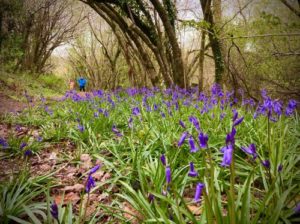
 Lady’s Smock (Cardamine pratensis)
Lady’s Smock (Cardamine pratensis)  Cowslips (primula veris)
Cowslips (primula veris) This cheery flower can be seen all over the place at this time of year, in woodlands, meadows, alongside the roadside and basically any place where it’s safe from grazing animals! Historically once much more prevalent, the cowslip is making a comeback and starting to return in droves after declining for a time due to modern farming techniques and the increased use of pesticides. Featured in two of Shakespeare’s works, this flower is well loved and was often associated with May Day in English traditions. Another fantastic herbal remedy, the flowers have been used for headache and insomnia remedies as well as making tasty wine (although perhaps the latter wouldn’t help with the headaches!)
 Forget-Me-Not (myosotis scorpioides)
Forget-Me-Not (myosotis scorpioides)These distinctive tiny blue flowers have many a tale bearing to the origins of the name. My favourite is that a prince was picking flowers for his beloved alongside a river, and lost his footing, falling to his watery grave. As he fell, he shouted ‘forget me not’! Whether true or not, it’s an easy way to remember that they like to grow near water from May through most of the summer. These flowers are also edible although I’ve yet to try them – some of my research suggested they’d be well used as cake decorations or in ice cubes as well as in salads.
 Snake’s-head Fritillary (fritillaria meleagris)
Snake’s-head Fritillary (fritillaria meleagris)I stumbled across this flower in a friend’s garden just a few weeks ago and was absolutely captivated by it! This absolute beauty is named as it apparently looks like a snake’s head (although I’m not convinced) and unfortunately it is classed as a vulnerable plant as our loss of meadows is reducing it’s available habitat. It is a particular friend to our pollinators so is an important one to try and preserve. Luckily, a lot of conservation charities are on the case with this one but apparently it’s easy to grow despite being wild so maybe worth having a go and helping to keep the species alive?
 Bluebell (Hyacinthoides non-scripta)
Bluebell (Hyacinthoides non-scripta)Copyright © Outdoors Group Ltd 2021. All Rights Reserved.
Registered Office: The Outdoors Group, Western Lodge, Crediton, Devon, EX17 3NH. Company number 10755829
Terms & Conditions / Website Terms / Privacy Policy / Sitemap / Built with ♥ by Solve